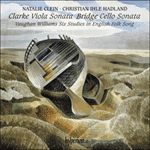
Welcome to Hyperion Records, a British classical label devoted to presenting high-quality recordings of music of all styles and from all periods from the twelfth century to the twenty-first.
Hyperion offers both CDs, and downloads in a number of formats. The site is also available in several languages.
Please use the dropdown buttons to set your preferred options, or use the checkbox to accept the defaults.

| Natalie Clein (cello), Christian Ihle Hadland (piano)» More |
I first played the Sonata with a contemporary pianist of his called Ada May Thomas. She told me that during the First World War, when Bridge was writing the slow movement, he was in utter despair over the futility of war and the state of the world generally and would walk round Kensington in the early hours of the morning unable to get any rest or sleep, and that the idea of the slow movement really came into being during that time.
As originally planned the elegiac slow movement and biting scherzo were to be separate and much longer, with an independent finale. Eventually Bridge compressed the elements into a single, intense ‘phantasy-arch’, the principal theme of which derives from the climax of the first movement’s exposition. What Benjamin Britten has referred to as Bridge’s ‘impatience with tonality’ is evident in the yearning chromaticism of the slow section and in the more aggressive bitonal and whole-tone colours in the scherzo section. To balance the two extended movements, Bridge added a lengthy coda, re-working the opening of the first movement in a much leaner and more incisive manner. The Sonata took Bridge four long years to finish and two of his musician friends, the cellist Felix Salmond and pianist Harold Samuel, gave the first performance at London’s Wigmore Hall in 1917.
from notes by Paul Hindmarsh © 2013
Les amis musiciens de Bridge, Felix Salmond et Harold Samuel, donnèrent la création au Wigmore Hall de Londres. Par la suite, l’interprétation de Salmond connut un immense succès en Europe et en Amérique. La première exécution à New York, organisée pour coïncider avec une tournée comme chef d’orchestre aux États-Unis organisée par sa nouvelle protectrice, eut lieu l’après-midi du 13 novembre 1923. Bridge continua à éprouver beaucoup d’affection pour cette sonate, qui est encore la plus largement jouée de ses longues pièces en duo.
extrait des notes rédigées par Paul Hindmarsh © 2019
Français: Marie-Stella Pâris
Die Uraufführung spielten die mit Bridge befreundeten Musiker Felix Salmond und Harold Samuel in der Londoner Wigmore Hall. In der Folge fand Salmonds Interpretation in Europa und Amerika viel Beifall. Die Erstaufführung in New York am 13. November 1923 wurde von Bridges neuer Gönnerin Coolidge so arrangiert, dass sie mit einer Tournee als Dirigent zusammenfiel. Die Sonate blieb für Bridge ein besonders wichtiges Werk; bis heute ist sie das meistaufgeführte seiner Werke in Duo-Besetzung.
aus dem Begleittext von Paul Hindmarsh © 2019
Deutsch: Friedrich Sprondel
 Clarke (R): Viola Sonata; Bridge: Cello Sonata Clarke (R): Viola Sonata; Bridge: Cello SonataA perfectly planned recital of English music from one of this country’s leading cellists.» More |

